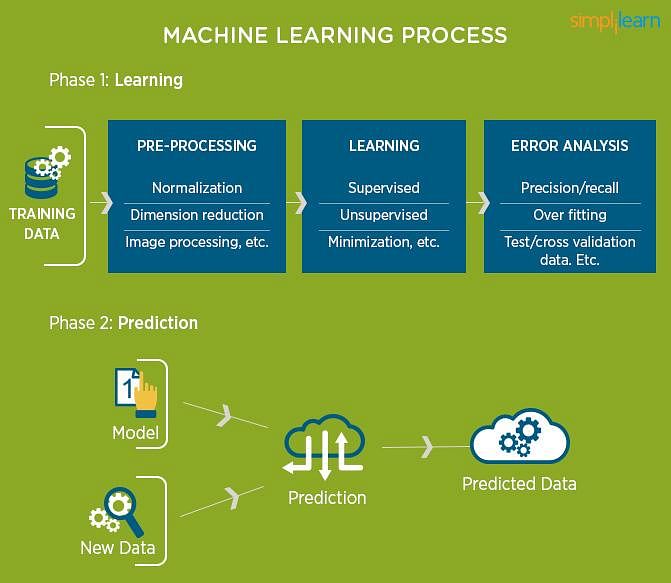Top Technology Trends for 2019 and the Jobs They’ll Create
 |
| Technology Trends |
Technology is now evolving at such a rapid pace that annual predictions of trends can seem out-of-date before they even go live as a published blog post or article. As technology evolves, it enables even faster change and progress, causing the acceleration of the rate of change, until eventually, it will become exponential.
Technology-based careers don’t change at that same speed, but they do evolve, and the savvy IT professional recognizes that his or her role will not stay the same. The IT worker of the 21st century will constantly be learning, out of necessity if not desire.
What does this mean for you? It means staying current with technology trends. And it means keeping your eyes on the future, to know which skills you’ll need to know and what types of jobs you want to be qualified to do.
Here are eight technology trends you should watch for in 2019, and some of the jobs that will be created by these trends. Because the time to train yourself for one of these emerging jobs is now.
1.Artificial Intelligence (AI)
Artificial Intelligence, or AI, has already received a lot of buzz in recent years, but it continues to be a trend to watch because its effects on how we live, work and play are only in the early stages. In addition, other branches of AI have developed, including Machine Learning, which we will go into below. AI refers to computers systems built to mimic human intelligence and perform tasks such as recognition of images, speech or patterns, and decision making. AI can do these tasks faster and more accurately than humans.
AI has been around since 1956 is already widely used. In fact, five out of six Americans use AI services in one form or another every day, including navigation apps, streaming services, smartphone personal assistants, ride-sharing apps, home personal assistants, and smart home devices. In addition to consumer use, AI is used to schedule trains, assess business risk, predict maintenance, and improve energy efficiency, among many other money-saving tasks.
AI is one part of what we refer to broadly as automation, and automation is a hot topic because of potential job loss. Experts say automation will eliminate 73 million more jobs by 2030. However, automation is creating jobs as well as eliminating them, especially in the field of AI: Pundits predict that jobs in AI will number 23 million by 2020. Jobs will be created in development, programming, testing, support, and maintenance, to name a few. Artificial Intelligence architect is one such job. Some say it will soon rival data scientist in need for skilled professionals.
To learn more about potential jobs in AI, read about builfing a carrer in AI or why you should earn an AI certification.
AI has been around since 1956 is already widely used. In fact, five out of six Americans use AI services in one form or another every day, including navigation apps, streaming services, smartphone personal assistants, ride-sharing apps, home personal assistants, and smart home devices. In addition to consumer use, AI is used to schedule trains, assess business risk, predict maintenance, and improve energy efficiency, among many other money-saving tasks.
AI is one part of what we refer to broadly as automation, and automation is a hot topic because of potential job loss. Experts say automation will eliminate 73 million more jobs by 2030. However, automation is creating jobs as well as eliminating them, especially in the field of AI: Pundits predict that jobs in AI will number 23 million by 2020. Jobs will be created in development, programming, testing, support, and maintenance, to name a few. Artificial Intelligence architect is one such job. Some say it will soon rival data scientist in need for skilled professionals.
To learn more about potential jobs in AI, read about builfing a carrer in AI or why you should earn an AI certification.
2.Machine Learning
| Machine learning |
Machine Learning is a subset of AI. With Machine Learning, computers are programmed to learn to do something they are not programmed to do: They literally learn by discovering patterns and insights from data. In general, we have two types of learning, supervised and unsupervised.
While Machine Learning is a subset of AI, we also have subsets within the domain of Machine Learning, including neural networks, natural language processing (NLP), and deep learning. Each of these subsets offers an opportunity for specializing in a career field that will only grow.
While Machine Learning is a subset of AI, we also have subsets within the domain of Machine Learning, including neural networks, natural language processing (NLP), and deep learning. Each of these subsets offers an opportunity for specializing in a career field that will only grow.

Machine Learning is rapidly being deployed in all kinds of industries, creating a huge demand for skilled professionals. The Machine Learning market is expected to grow to $8.81 billion by 2022. Machine Learning applications are used for data analytics, data mining and pattern recognition. On the consumer end, Machine Learning powers web search results, real-time ads, and network intrusion detection, to name only a few of the many tasks it can do.

In addition to completing countless tasks on our behalf, it is generating jobs. Machine Learning jobs rank among the top emerging jobs on LinkedIn, with almost 2,000 job listings posted. And these jobs pay well: In 2017, the median salary for a machine learning engineer was $106,225. Machine Learning jobs include engineers, developers, researchers, and data scientists.
Machine Learning: What it is and Why it Matters
What is Machine Learning?
A good start at a Machine Learning definition is that it is a core sub-area of Artificial Intelligence (AI). ML applications learn from experience (well data) like humans without direct programming. When exposed to new data, these applications learn, grow, change, and develop by themselves. In other words, with Machine Learning, computers find insightful information without being told where to look. Instead, they do this by leveraging algorithms that learn from data in an iterative process.
While the concept of Machine Learning has been around for a long time (think of the WWII Enigma Machine), the ability to automate the application of complex mathematical calculations to Big Data has been gaining momentum over the last several years.
At a high level, Machine Learning is the ability to adapt to new data independently and through iterations. Basically, applications learn from previous computations and transactions and use “pattern recognition” to produce reliable and informed results
pro Tip: Fast-track your learning, consider Simplilearn’s comprehensive Machine Learning Certification Training. With modules in supervised and unsupervised learning, deep learning, Spark, and live industry projects, you can become a job-ready Machine Learning specialist in just a few weeks!
Why Machine Learning?
To better understand the uses of Machine Learning, consider some instances where Machine Learning is applied: the self-driving Google car; cyber fraud detection; and, online recommendation engines from Facebook, Netflix, and Amazon. Machines can enable all of these things by filtering useful pieces of information and piecing them together based on patterns to get accurate results.
The process flow depicted here represents how Machine Learning works:

The rapid evolution in Machine Learning has caused a subsequent rise in the use cases, demands—and, the sheer importance of ML in modern life. Big Data has also become a well-used buzzword in the last few years. This is, in part, due to the increased sophistication of Machine Learning, which enables the analysis of large chunks of Big Data. Machine Learning has also changed the way data extraction and interpretation are done by automating generic methods/algorithms, thereby replacing traditional statistical techniques.
Uses of Machine Learning
Typical results from Machine Learning applications we either see or don’t regularly include web search results, real-time ads on web pages and mobile devices, email spam filtering, network intrusion detection, and pattern and image recognition. All these are by-products of using Machine Learning to analyze massive volumes of data.
Traditionally, data analysis was trial and error-based, an approach that becomes impossible when data sets are large and heterogeneous. Machine Learning provides smart alternatives to analyzing vast volumes of data. By developing fast and efficient algorithms and data-driven models for real-time processing of data, Machine Learning can produce accurate results and analysis.
Pro Tip: For more on Big Data and how it’s revolutionizing industries globally, check out our article about what Big Data is and why you should care.
According to a related report by McKinsey, “As ever more of the analog world gets digitized, our ability to learn from data by developing and testing algorithms will only become more important for what is now seen as traditional businesses.” The same report also quotes Google’s chief economist Hal Varian who calls this “computer kaizen” and adds, “just as mass production changed the way products were assembled, and continuous improvement changed how manufacturing was done… so continuous (and often automatic) experimentation will improve the way we optimize business processes in our organizations.” Clearly, Machine Learning is here to stay.
3.Robotic Process Automation or RPA
Like AI and Machine Learning, Robotic Process Automation, or RPA, is another technology that is automating jobs. RPA is the use of software to automate business processes such as interpreting applications, processing transactions, dealing with data, and even replying to emails. RPA automates repetitive tasks that people used to do. These are not just the menial tasks of a low-paid worker: up to 45 percent of the activities we do can be automated, including the work of financial managers, doctors, and CEOs.
Although Forrester Research estimates RPA automation will threaten the livelihood of 230 million or more knowledge workers or approximately 9 percent of the global workforce, RPA is also creating new jobs while altering existing jobs. McKinsey finds that less than 5 percent of occupations can be totally automated, but about 60 percent can be partially automated.
For you as the IT professional looking to the future and trying to understand technology trends, RPA offers plenty of career opportunities, including developer, project manager, business analyst, solution architect, and consultant. And these jobs pay well. SimplyHired.com says the average RPA salary is $73,861, but that is the average compiled from salaries for junior-level developers up to senior solution architects, with the top 10 percent earning over $141,000 annually.
If you’re interested in pursuing a career in RPA, the Introduction to Robotic Process Automation (RPA) course is the place to start.
Although Forrester Research estimates RPA automation will threaten the livelihood of 230 million or more knowledge workers or approximately 9 percent of the global workforce, RPA is also creating new jobs while altering existing jobs. McKinsey finds that less than 5 percent of occupations can be totally automated, but about 60 percent can be partially automated.
For you as the IT professional looking to the future and trying to understand technology trends, RPA offers plenty of career opportunities, including developer, project manager, business analyst, solution architect, and consultant. And these jobs pay well. SimplyHired.com says the average RPA salary is $73,861, but that is the average compiled from salaries for junior-level developers up to senior solution architects, with the top 10 percent earning over $141,000 annually.
If you’re interested in pursuing a career in RPA, the Introduction to Robotic Process Automation (RPA) course is the place to start.

4.Blockchain

Although most people think of blockchain technology in relation to cryptocurrencies such as Bitcoin, blockchain offers security that is useful in many other ways. In the simplest of terms, blockchain can be described as data you can only add to, not take away from or change. Hence the term “chain” because you’re making a chain of data. Not being able to change the previous blocks is what makes it so secure. In addition, blockchains are consensus-driven, as explained in this Forbes article, so no one entity can take control of the data. With blockchain, you don’t need a trusted third-party to oversee or validate transactions.
This heightened security is why blockchain is used for cryptocurrency, and why it can play a significant role in protecting information such as personal medical data. Blockchain could be used to drastically improve the global supply chain, as described here, as well as protect assets such as art and real estate.
And as the use of blockchain technology increases, so too does the demand for skilled professionals. In that regard, we are already behind. According to Techcrunch, blockchain-related jobs are the second-fastest growing category of jobs, with 14 job openings for every one blockchain developer. A blockchain developer specializes in developing and implementing architecture and solutions using blockchain technology. The average yearly salary of a blockchain developer is $130,000.
The job of a developer is not the only one available in the blockchain space, however. Employers are also looking for software engineers, consultants and project managers. Jobs are available at financial institutions, but also in retail and healthcare, and soon probably manufacturing as well.
5.Virtual Reality and Augmented Reality
Although VR has primarily been used for gaming thus far, it has also been used for training, as with VirtualShip,
a simulation software used to train U.S. Navy, Army and Coast Guard ship captains. The popular Pokemon Go is an example of AR.
Both have enormous potential in training, entertainment, education, marketing, and even rehabilitation after an injury. Either could be used to train doctors to do surgery, offer museum-goers a deeper experience, enhance theme parks, or even enhance marketing, as with this Pepsi Max bus shelter.
According to an article at Monster.com, the demand for job candidates with VR knowledge is up 37 percent, but the potential employees are in short supply. That demand will only increase. There are major players in the VR market, like Google, Samsung, and Oculus, but plenty of startups are forming and they will be hiring—or trying to, in light of the shortage. Getting started in VR doesn’t require a lot of specialized knowledge. Basic programming skills and a forward-thinking mindset can land a job, although other employers will be looking for optics as a skill-set and hardware engineers as well.
6.Cyber Security

As proof of the strong need for cybersecurity professionals, the number of cybersecurity jobs is growing three times faster than other tech jobs. However, we’re falling short when it comes to filling those jobs. As a result, it’s predicted that we will have 3.5 million unfilled cybersecurity jobs by 2021.
Many cybersecurity jobs pay six-figure incomes, and roles can range from the ethical hacker to security engineer to Chief Security Officer, offering a promising career path for someone who wants to get into and stick with this domain.
7.Internet of Things


As consumers, we’re already using and benefitting from IoT. We can lock our doors remotely if we forget to when we leave for work and preheat our ovens on our way home from work, all while tracking our fitness on our Fitbits and hailing a ride with Lyft. But businesses also have much to gain now and in the near future. The IoT can enable better safety, efficiency, and decision making for businesses as data is collected and analyzed. It can enable predictive maintenance, speed up medical care, improve customer service, and offer benefits we haven’t even imagined yet. However, despite this boon in the development and adoption of IoT, experts say not enough IT professionals are getting trained for IoT jobs. An article at ITProToday.com says we’ll need 200,000 more IT workers that aren’t yet in the pipeline, and that a survey of engineers found 25.7 percent believe inadequate skill levels to be the industry’s biggest obstacle to growth.
For someone interested in a career in IoT, that means easy entry into the field if you’re motivated, with a range of options for getting started. Skills needed include IoT security, cloud computing knowledge, data analytics, automation, understanding of embedded systems, device knowledge, to name only a few. After all, it’s the Internet of Things, and those things are many and varied, meaning the skills needed are as well.
Although technologies are emerging and evolving all around us, these eight domains offer promising career potential now and for the foreseeable future. And all eight are suffering from a shortage of skilled workers, meaning the time is right for you to choose one, get trained, and get on board at the early stages of the technology, positioning you for success now and in the future.
Comments
Post a Comment